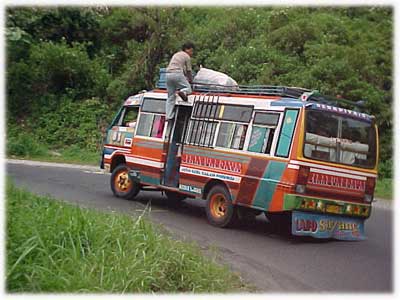KARO
TRADITIONAL HOUSE
Karonese
as one of the oldest tribe to settle in the North Sumatera district, has a
unique heritage, form of a traditional house. The house built in the early
years of Highlands Movements were made to protect the people from wild beast
and jungle cruelty. They were able to remain safe and protected, laid shelter
from rains and wetlands. It was simply built among trees and shack rooftops.
The shack indeed was constructed to follow the river streams facing west and
east, so the inner inhabit could lay guard on what is going on the river bed.
There
are many types of Karo traditional houses, seen from its family member. There used
to be eight types of houses among the Karonese, but we only could see two
remaining types. The first type was called the GERGA, a place for the King / Sibayak
/ Raja to live personally with his family. Known as a king’s sanctuary, this
place forbids outer family member to enter. Another type of this building is
known as the MBELANG AYO. Due to its
extinction, scientist could not differ the two kinds of building.
A
common house known today is the empat
(4) jabu and the waluh (8) jabu as it
could be seen in Lingga, a famous traditional village near Kabanjahe fame for
ethnical tangible and intangible heritages. The houses named after the number
of inhabits doubling in twice, so the empat jabu
is for 4 families, enem jabu for 6
families, and it ended with the sepuluh enem jabu for 16 extended families. Known to all, the waluh jabu is most popular among all as it
still seen today. Si enem (6) jabu, sepuluh (10), and dua belas
jabu (12) is not common among people
due to its extinction many years ago. Sepuluh
enem (16) jabu is the largest of
them all, known to all as the king’s palace. The last one seen was possessed to
Sibayak Rumah Kabanjahe and was burnt
in the independence revolution. The local government inherit the burnt building
by establishing a dummy very similar to its original, placing it at the main
office of Pemkab Karo and Terminal Kabanjahe bus stop.
Beside
a traditional house, a village would consist of five other buildings to
complete its status as a well village. First there must be a JAMBUR, place where locals and
adolescent sleep outer the houses. A jambur also is functioned as the town
hall, meeting places and courtesy. Then there is a GERITEN beside a house to preserve the skulls of ancestors,
believing that being placed in geriten, the spirits of our predecessors will
shelter near our homes, protecting us. Finally to keep the grains safe,
Karonese built SAPO PAGE, LESUNG and KEBEN. Sapo page is built as a leisure spot for the host, lesung is
made for thumping and pounding rice grains, in order to separate the wheat from
grains. Last but not least, Keben is constructed by rich peoples to show their
power and dignity, but the function of these three buildings are the same, to
stockpile rice.
NOTE:
1.
Due to the harsh struggle for
independence, we cannot find a village with detail mapping and complete
structure of all buildings. Many were burnt down to forbid the Dutch of using
it as basecamp in later days. Many more were burnt down as a reaction of
dissatisfaction towards Kings ruling the area of East Sumatera in 1947.
2.
You could visit Museum Lingga in
Lingga (20 minutes ride from Kabanjahe) and Dokan (10 minutes from Berastagi)
to see the well preserved traditional house.
3.
You could also see the traditional
house in Taman Mini Indonesia Indah (TMII) Jakarta Timur.
4.
You could also visit traditional
villages of Kabupaten Karo to see inappropriate houses in Batukarang, Perbaji, and
Kutabuluh Simole.
SOURCES:
1.
http://planetbatak.blogspot.co.id/2013/09/rumah-adat-karo.html
(accessed at 24/02/2016 21:15 wib)
2.
http://www.ketadu.com/2012/02/rumah-adat-karo-rumah-siwaluh-jabu.html
(Accessed at 24/02/2016 21.35 wib)
3.
My special thanks to my beloved and
always supportive girl Savedia Lania Olga Sembiring Meliala, with restless and
endless prayers. God Bless.

